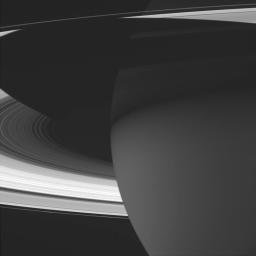The Adventure Ahead
Caption:
This majestic view of Saturn captures several phenomena of interest to scientists working on the Cassini mission. The planet's nighttime atmosphere looms ahead -- an excellent place to search for storms and lightning. Saturn's shadow stretches across the rings, which will over the next four years receive their most thorough examination since Galileo discovered them in 1610. And barely visible near lower right just inside the F ring, is the small shepherd moon Prometheus (102 kilometers, or 63 miles across). Researchers will explore the many moons of Saturn, including special ones like Prometheus that help maintain some of the rings and gaps in this complex and dynamic system.
The image was taken in visible light with the Cassini spacecraft wide angle camera on Oct. 29, 2004, at a distance of about 940,000 kilometers (584,000 miles) from Saturn. The image scale is 52 kilometers (33 miles) per pixel.
Background Info:
The Cassini-Huygens mission is a cooperative project of NASA, the European Space Agency and the Italian Space Agency. The Jet Propulsion Laboratory, a division of the California Institute of Technology in Pasadena, manages the Cassini-Huygens mission for NASA's Office of Space Science, Washington, D.C. The Cassini orbiter and its two onboard cameras, were designed, developed and assembled at JPL. The imaging team is based at the Space Science Institute, Boulder, Colo.
For more information, about the Cassini-Huygens mission visit,
http://saturn.jpl.nasa.gov
and the Cassini imaging team home page,
http://ciclops.org
.
Cataloging Keywords:
| Name |
Value |
Additional Values |
| Target |
Saturn |
F Ring, Prometheus, Saturn Rings |
| System |
Saturn |
|
| Target Type |
Planet |
Ring, Satellite |
| Mission |
Cassini-Huygens |
|
| Instrument Host |
Cassini Orbiter |
|
| Host Type |
Orbiter |
|
| Instrument |
Imaging Science Subsystem (ISS) |
|
| Detector |
Wide Angle Camera |
|
| Extra Keywords |
Atmosphere, Gap, Grayscale, Shadow, Storm, Visual |
| Acquisition Date |
|
| Release Date |
2004-12-08 |
| Date in Caption |
2004-10-29 |
|
| Image Credit |
NASA/JPL/Space Science Institute |
| Source |
photojournal.jpl.nasa.gov/catalog/PIA06538 |
| Identifier |
PIA06538 |

 Planetary Data System
Planetary Data System
